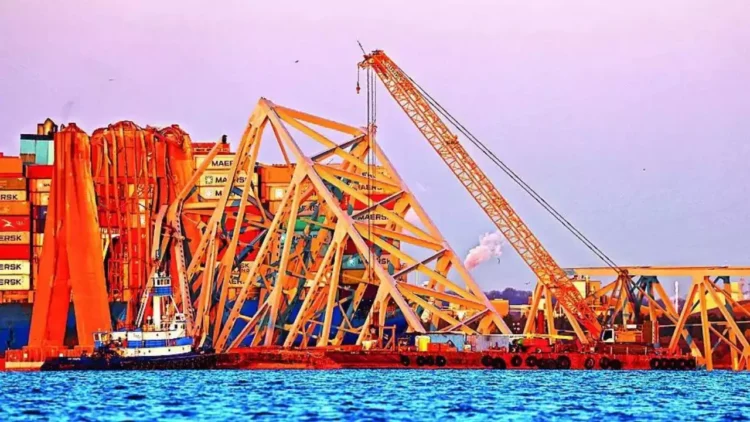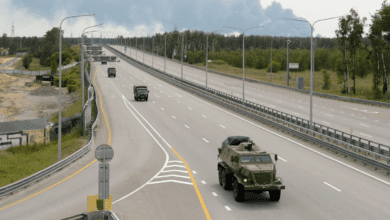Dali’s 22-person Indian team is still entangled in steel after six days
The devastation of Baltimore’s Francis Scott Key Bridge is a startling sight, even from a distance. Twisted grey beams and chunks of steel that stick above the water like metallic icebergs emerge as the 985-foot cargo ship “Dali,” which slammed the bridge on March 26 and killed six people, lies trapped in the ruins.

The 22 Indian crew members who are still stranded aboard the ship are less noticeable, but their timely alert saved many more lives.
They are responding to a barrage of inquiries from authorities looking into the disaster while keeping the ship in service. There’s no doubt about it: they won’t be docking anytime soon because they need to wait for enough debris to be removed in order to release the ship and reopen the passage to one of the busiest ports in the US.
There’s been no word on when the ship could be recovered from the US bridge damage.
The only information available to the public about the 22 Indian crew members is that they are seafarers who set out on a journey aboard the cargo ship “Dali,” which was carrying 4,700 shipping containers to Sri Lanka when it lost power and struck Baltimore’s Key Bridge, resulting in the structure collapsing on March 26.
The crew members have unexpectedly become well-known after the catastrophe. This past week, a concern has surfaced as investigators look into possible causes of the tragedy: what might the crew, with their restricted contact with outside worlds, be going through at this moment?
According to Joshua Messick, the executive director of the Baltimore International Seafarers’ Centre, a Christian group that works to defend the rights of seamen, “they must feel this weight of responsibility that they couldn’t stop it from happening.”
Nevertheless, authorities applauded the crew for sending out a prompt Mayday call over radio on Tuesday after the ship lost power. The Mayday call assisted police officers in stopping vehicles from entering the bridge before the Dali, which was moving at a speed of eight knots, and is thought to have saved many lives, according to officials. Along with an apprentice pilot in training, there was a veteran harbour pilot from the area who had over ten years of expertise.
The crew members’ lives are now in an uncertain phase as the ship is still trapped in the Port of Baltimore, where it may stay for weeks. One thing is for sure, though: They won’t be taking that trip across South Africa any time soon in order to go to Sri Lanka.
Therefore, in order to keep the ship in condition equivalent to what they would have had if they were at sea, crew members are probably working a demanding schedule at this time. According to specialists, the distinction is that they remain still while the whole world is staring at them.
“The crew and the captain of the vessel have a duty to the ship,” said Stephen Frailey, a partner with Pacific Maritime Group, an organisation that assists with wreck disposal and maritime salvage.
The crew members have enough food and drink, as well as gasoline, to run the generators, according to Chris James, a consultant with a business that supports Synergy Marine, the ship’s management company. In fact, this past week, Jennifer Homendy, the head of the National Transportation Safety Board, visited the ship and saw the kitchen in action. She said, “It smelled really good.”
However, James noted that a precise schedule for the ship’s possible extraction from the debris is yet unknown. After the Coast Guard and NTSB complete their investigations, he said, “We’ll look at potentially swapping the crew out and getting them home.”
The crew members’ native nation of India is among the major global hotspots for seafarers, according to John A. Konrad, CEO of gCaptain, a news website covering the maritime and offshore industries and a ship captain. According to Konrad, Indian captains and engineers earn a respectable living when they operate at sea for three or more months of the year while receiving lower pay than their American colleagues.
He said that working aboard a cargo ship is a 24-hour job that doesn’t allow for weekends off. Every day, personnel in the engine room keep everything running smoothly, chefs and cleaners feed the other members, and decks are inspected for safety and upkeep.
However, there are certain recreational opportunities for cargo ship crew members on board, including movie evenings, video gaming breaks in cabins, gym exercises, and table tennis sessions. According to Andrew Middleton, who oversees Apostleship of the Sea, a programme that provides spiritual support to sailors passing through the port, the Dali crew carries a minimum of a TV, periodicals, and literature on board.
Clistan An Indian seafarer named Joy Sequeira, who arrived in Baltimore on Friday from a different cargo ship but wasn’t aboard the Dali, expressed his concern in an interview about the potential effects of the bridge collapse on his nation and business.
“I’m scared that because this crew is Indian, our international image will suffer,” Sequeira, 31, added. “Maybe we lose jobs.”
Some members of the port community in Baltimore have had sporadic communication—through third parties or WhatsApp—with the Dali crew. Because they lacked internet access on board, Messick claimed to have given the crew two Wi-Fi hot spots on Friday.
In his communication with two crew members, Middleton said, he has been letting them know that
“we’re here for them.” “When I’ve asked how they’re doing, their answers range from ‘good’ to ‘great,'” he said. “So, by their own accounts, they’re okay.”
Messick said that he had used a salvage business that assisted with operations to send a comfort gift to the crew. There were candies, homemade muffins from a worried neighbour, and little ones’ thank-you notes within the present.
Messick expressed his eagerness to provide the crew members with trauma treatment and emotional support, given the many unresolved issues about their future course of action. He sent the captain a letter on Friday, and another ship brought it to him.
It said, “We’re here to support you.”







